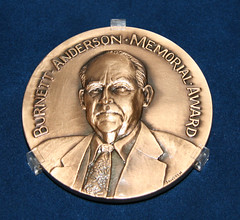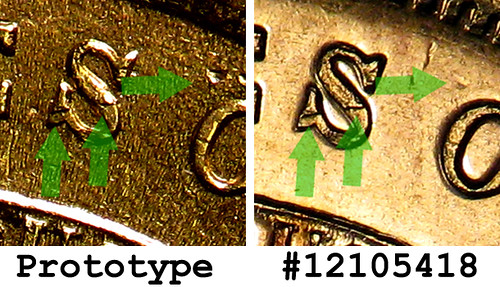
About UsThe Numismatic Bibliomania Society is a non-profit organization promoting numismatic literature. For more information please see our web site at coinbooks.org SubscriptionsThose wishing to become new E-Sylum subscribers (or wishing to Unsubscribe) can go to the following web page link MembershipThere is a membership application available on the web site Membership Application To join, print the application and return it with your check to the address printed on the application. Membership is only $15 to addresses in the U.S., $20 for First Class mail, and $25 elsewhere. For those without web access, write to: David M. Sundman, Secretary/TreasurerNumismatic Bibliomania
Society AsylumFor Asylum mailing address changes and other membership questions, contact David at this email address: dsundman@LittletonCoin.com SubmissionsTo submit items for publication in The E-Sylum, just Reply to this message, or write to the Editor at this address: whomren@coinlibrary.com
BUY THE BOOK BEFORE THE COINYou won't regret it! |
- WAYNE'S WORDS: THE E-SYLUM AUGUST 10, 2008
- 2008 NBS GENERAL MEETING REPORT
- MORE ON THE BURNETT ANDERSON MEMORIAL AWARD FOR NUMISMATIC WRITING
- DAVID SKLOW NUMISMATIC LITERATURE AUCTION SALES
- ANA CONVENTION MEETING ON THE SUSPECT U.S. ASSAY OFFICE OF GOLD $20S
- DON KAGIN ON THE ORIGIN OF THE PIONEER GOLD FORUM
- ALAN WEINBERG'S 2008 BALTIMORE ANA DIARY
- EARLY U.S. QUARTERS AND DOLLARS IN THE ERIC P. NEWMAN COLLECTION
- DANIEL CARR DESIGNS WIZARD COIN SUPPLY 2008 ANA COMMEMORATIVE TOKEN
- QUERY: LOST CAUSE MEMORIAL PLAQUES
- MORE ON BUTTONS AND COINS
- QUERY: ENGRAVED 1921-D MORGAN DOLLARS
- THIS IS TO CRY: ARTICLE DETAILS HISPANIC SOCIETY OF AMERICA'S PLANS
- ASSOCIATED ITEMS ADD INTEREST AND COLOR TO ARTICLES AND BOOKS
- WAYNE'S NUMISMATIC DIARY: AUGUST 2, 2008
- MONEY IN MOTION: NUMISMATIC EXHIBIT AT PHILADELPHIA FEDERAL RESERVE BANK
- WISCONSIN NEWSPAPER NOTES LOCAL BUSINESS MENTIONED IN BURDETTE BOOK
- FOREIGN COINS JAMMING COUNTING MACHINES DONATED TO UNICEF
- CANADA'S KING'S POLICE AND FIRE SERVICE MEDAL
- SALE OF VICTORIA CROSS REPLICAS CRITICIZED
- DENVER MINT TO CLOSE DURING 2008 DEMOCRATIC NATIONAL CONVENTION
- AUTHOR RUSTY GOE REWARDS YOUNG NUMISMATIST
- BOOK TOWNS: SCENIC VILLAGES DEVOTED TO USED BOOKS
- HOW DID FLIPPING A COIN BECOME A DECISION-MAKER?
- FEATURED WEB PAGE: YAP STONE MONEY
WAYNE'S WORDS: THE E-SYLUM AUGUST 10, 2008
 Among our recent subscribers are John Herzog
and Douglas Nyholm, courtesy of John and Nancy Wilson, and Steve Ferguson.
Welcome aboard! We now have 1,170 subscribers.
Among our recent subscribers are John Herzog
and Douglas Nyholm, courtesy of John and Nancy Wilson, and Steve Ferguson.
Welcome aboard! We now have 1,170 subscribers. This week we open with a report on the NBS general meeting at last week's ANA, and comments on the Burnett Anderson Award for numismatic writing. Next, we have a preview of David Sklow's upcoming numismatic literature sale.
This issue has a number of items related to the ANA convention, the highlight of which from a numismatic research standpoint has to be the Pioneer Gold Forum meeting on the suspect 1853 U.S. Assay Office of Gold pieces. In the "OMG what a gorgeous coin" department is a report on the John Reich Collector's Society meeting on the Eric P. Newman collections of early U.S. quarters and dollars. Alan Weinberg and I each have ANA Diaries this week.
Queries this week address the "Lost Cause" plaques related to U.S. Confederate paper money and U.S. Mint-engraved 1921-D Morgan dollars.
In the news, an article delves into goings-on at the Hispanic Society of America and Sotheby's cataloging of the coin collection at the ANS. Other news items cover topics such as a new exhibit at the Philadelphia Federal Reserve, and sales of replica medals. To learn how and why coins were first "flipped" to make a decision, read on. Have a great week, everyone.
Wayne Homren
Numismatic Bibliomania Society
2008 NBS GENERAL MEETING REPORT
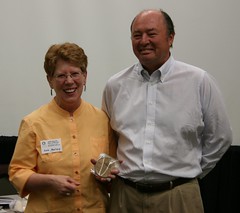 Following the business agenda, Anne Bentley,
senior curator at the Massachusetts Historical Society, gave a fascinating
talk on the various numismatic publications issued by the Society over the
years as well as citing some of the outstanding coins, medals and
literature currently under her care. With the ANA Convention coming to
Boston in 2010 (only two blocks away from the MHS), there was rush to sign
up for an on-site visit. Anne promised to have a special exhibit put up
for the occasion and, we suspect, there will be standing room only. As a
speakers gift, Anne was presented with a medal (found on the bourse floor)
issued to accompany the John F. Kennedy award, an award sponsored by her
employer, the MHS !
Following the business agenda, Anne Bentley,
senior curator at the Massachusetts Historical Society, gave a fascinating
talk on the various numismatic publications issued by the Society over the
years as well as citing some of the outstanding coins, medals and
literature currently under her care. With the ANA Convention coming to
Boston in 2010 (only two blocks away from the MHS), there was rush to sign
up for an on-site visit. Anne promised to have a special exhibit put up
for the occasion and, we suspect, there will be standing room only. As a
speakers gift, Anne was presented with a medal (found on the bourse floor)
issued to accompany the John F. Kennedy award, an award sponsored by her
employer, the MHS !The foregoing events consumed 50 minutes of the allotted hour with an auction conducted by Brad Karoleff taking the final 10 minutes and another fifty. Always entertaining, Brad was absolutely hilarious as he extracted large sums from all those who could not find cover. The total raised in one hour was not much less than a full year of dues and, even at that, none of the buyers felt regret because of the high quality of the items offered (including a specially bound copy of ye editor's London Diary).
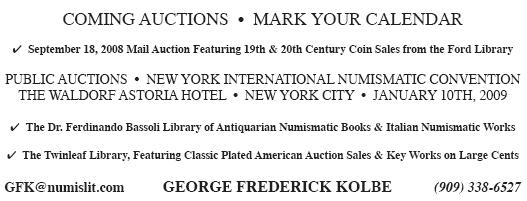
MORE ON THE BURNETT ANDERSON MEMORIAL AWARD FOR NUMISMATIC WRITING
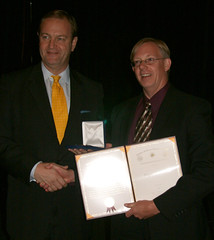

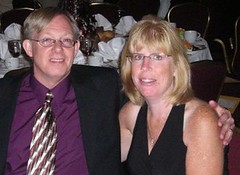 Many thanks for your kind words, everyone.
Knowing that my efforts are appreciated are what keep me going week after
week (it sure ain't the money). I'm glad my wife Dee was able to attend
the banquet and hear some of the comments first-hand. She has no interest
in numismatics but she's a dear for putting up with the time I devote to
it. When asked if I spend a lot of time on the computer, she'd laugh and
say "I see a lot of the back of his head." It's true. As I type this, the
kids are in bed, she's relaxing on the couch watching television, and I'm
in my library tapping away on the keyboard.
Many thanks for your kind words, everyone.
Knowing that my efforts are appreciated are what keep me going week after
week (it sure ain't the money). I'm glad my wife Dee was able to attend
the banquet and hear some of the comments first-hand. She has no interest
in numismatics but she's a dear for putting up with the time I devote to
it. When asked if I spend a lot of time on the computer, she'd laugh and
say "I see a lot of the back of his head." It's true. As I type this, the
kids are in bed, she's relaxing on the couch watching television, and I'm
in my library tapping away on the keyboard. Replying to Dan Gosling's question, she said, "He even takes the laptop on vacation with us - he's never without it." That's true, too. While it takes less time each week than most people think, the only way I can deal with editing The E-Sylum is to keep up with it constantly. It only takes a few seconds here, a few minutes there, and maybe a half an hour a few evenings a week. I hate falling behind, so I stir the pot a little every day, even in hotels. Sometimes I end up with a pedestrian beef stew, but on good weeks The E-Sylum's a tasty gumbo of numismatic information and commentary. Keep sending those ingredients my way, day or night! -Editor
Roger deWardt Lane writes:
Clifford Mishler writes:
DAVID SKLOW NUMISMATIC LITERATURE AUCTION SALES
Catalogs available by request; Send inquiries to: David Sklow-Fine Numismatic Books, P. O. Box 6321, Colorado Springs, CO 80934. Telephone: (719)-302-5686; Fax: (719)-302-4933; Email: numismaticbooks@aol.com. The catalog is currently accessible on-line: www.finenumismaticbooks.com Bids will be accepted by, telephone, fax, email and regular mail.
Several sale highlights: 1929 Convention Photo of the ANA; Chapman sales (Bement & Jackman) with plates from the original glass negatives; original Crosby, Early Coins of America; De Knight.s History of the Currency 1900; a long run of Thomas Elder sales (101); King.s original manuscript on Lincoln Medals; Phillips Historical Sketches of the Paper Money of the American Colonies 1865-66; Steigerwalt.s first twenty-five numbered sales; Young.s 1903 United States Mint at Philadelphia; Rare original photograph of .Ye Olde Mint. by Robert Newell & Son; Rare original letters of Byron Johnson;
Several unique manuscripts by James J. Curto on tokens; a long run of monographs 1893-2003 from The Numismatist, some very rare; the Invasion of Louisville photo album 1988 (Armand Champa); complete set of the Asylum; set of Wilson.s Repository; B. Max Mehl Star Building presentation photo set of Kenneth Lowe #3 of 4; run of deluxe Superior sales; Burn.s London Trade, Tavern & Coffee House tokens; rare bound six catalogs of Dr. Mead.s collection 1754-1756; complete volume #5 1892 of The Numismatist; Newcomb.s 1801-02-03 work on U.S. Large cents; very nice first edition Redbook; rare 1910 ANA Yearbook; rare Yale College catalogue of their coin cabinet 1863; Neumann.s Beschreibung Der Bekanntesten Kupfermunzen seven volumes new York 1965-66; and something for everyone!
Consignments are now being accepted for all future sales.
Web site: www.finenumismaticbooks.com
E-Mail: numismaticbooks@aol.com
DAVID SKLOW-FINE NUMISMATIC BOOKS
P.O. Box 6321
Colorado Springs, CO 80934
Telephone: (719) 302-5686
Fax: (719) 302-4933
THE BOOK BAZARRE
ANA CONVENTION MEETING ON THE SUSPECT U.S. ASSAY OFFICE OF GOLD $20S
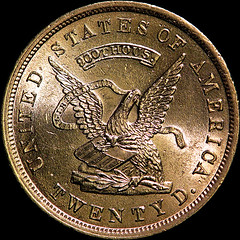
I was unable to attend the event, but some folks who did have provided the following accounts. George Fuld provided an opening background piece - some of the details have never before been published. -Editor
George Fuld writes:
The study group consisted of Abe Kosoff, Dr. Sloss and myself and plus Eric Newman in the following months. Ryan, who was the owner of one of .proof-like. pieces questioned the status of his piece, and made it available to me. Jim Sloss supplied one .proof-like. piece, Abe Kosoff supplied another and three high grade uncirculated .900 Fine specimens. Abe also borrowed and sent me the Philadelphia Mint strike (circa 1858) proof ex Farouk.
We had in summary three .proof-like. coins, three high grade regular issues and the Farouk proof. Studies made at the time included high resolution photomicrographs, X-ray diffraction patterns and spectrographic metal analysis.
Also, one .proof-like. was submitted to an agent of the Secret Service to see if they would determine the status of these coins. After several months, they decided since the USAO office was not officially a Mint until 1854, they would not subject the coin to a study.this was not a U S coin in their opinion.
The study lingered, as I had a bout of illness, and the coins were returned to their owners.all the results were sent to Eric Newman who carried the ball from there.
The buyer went to the PNG in an effort to get his money back (the amount was $3,000 as I recall). As the .proof-like. pieces originated with John Ford (who obtained them from Paul Franklin), Ford prepared a defense of the USAO hoard. It was a 100 plus page dissertation asserting that the .proof-likes. were a series of experimental alloy pieces obtained from a banker in Arizona. Eric Newman prepared a thesis condemning the pieces in great detail. A hearing was made before three .judges. from PNG in 1968. No definite conclusion was reached, but the committee ruled that they were not proofs, and that Ryan should get his money refunded. Actually Ryan had to go to court to get the refund, as the seller of the coin refused to pay back for the coin.
In the following years, many discussions were held about the Ford-Franklin hoard. T. V. Buttrey and John Kleeberg condemned these pieces in great detail. A great debate was held at the 1997 ANA convention with Kleeberg presenting his views and Michael Hodder saying that most of the questionable coins (including various ingots, trial pieces, etc.) were genuine. Both studies were published in the American Journal of Numismatics. A law suit was launched by Ford and Stack.s against Buttrey which has never been resolved
The last public sale of a .proof-like. twenty was in the 1981 Bowers & Ruddy Henry Clifford sale. The write up of the coin was done by John Ford and the coin sold for $17,000.
Late last year, a USAO $20 was sent on consignment to Kagin.s. David McCarthy examined the piece and realized that it looked familiar. The coin was an MS-64 uncirculated specimen with the standard 164 reeds on the edge. It became obvious that this coin was a prototype for the .proof-like. twenties. Visually it was obvious that the Franklin-Ford coins were made from a transfer die from this uncirculated copy. Actually, the progression of issuance from the transfer dies, all with 170 reeds, was determined by John Dannreuther.
The first strikings were frosty uncirculated issues (possibly 200 were made), then a number of semi-proof like issues and finally the seven or so .proof-likes.. A thorough series of photographs of a number of USAO issues is on the Pioneer-Gold Forum website.
Open questions that still remain is how were the transfer dies made (explosive impact transfer would destroy the original coin). At the forum held on August 2nd at ANA the discussion was made about possible transfer processes, the origin of gold metal in the 1950.s (gold was not allowed to held except for certain jewelry uses and as rare numismatic items until 1974), and where the coins were made. The production of these coins was highly sophisticated--they certainly were not made in a garage in Massapequa on Long Island. In summary, it was agreed by all in attendance, that if these pieces were submitted for grading to the leading authentication services, they would be called .transfer die forgeries..
The last word on these intriguing issues has not been written, but it is obvious that they are not 1853 official issues from the U S Assay Office!!
About 50 people were in attendance for the event including, Don Kagin, Fred Holabird, George Fuld, David McCarthy, John Dannreuther, Ron Guth, Stu Levine, John Kleeberg, Tony Terranova, J. P. Martin, Andy Lustig, Steve Graham, Mark Van Winkle, David Hall, Ira Goldberg, Laura Robins and Will Robins.
Fred Holabird writes:
I was very happy at the sincere involvement of McCarthy, Kagin, George Fuld, John Dannreuther, Dave Bowers and others, who all took the time to personally inspect the coins. George provided an excellent professional paper that discussed the difference between a planchet produced from a rolling effect (rolling out of an ingot, continually thinning) versus modern made. I was hoping to show this with a chalk board and my recent studies with SEM/EDS, but we couldn.t find any chalk anywhere nearby. So I discussed it out loud.


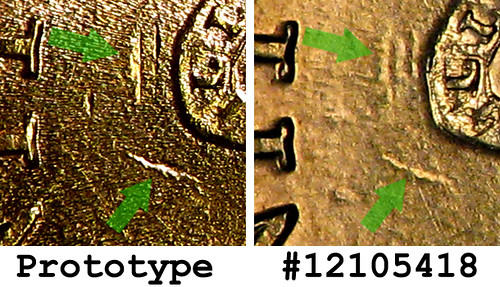
As a member of the Forum, Tom DeLorey wrote:
The numerous repeating random contact marks copied from the prototype are proof that the copy dies were made from the prototype coin. They could not have been on the original, genuine dies, or otherwise there would be multiple genuine coins (without the unusual finish and other characteristics of the Franklin pieces) with these same random marks.
I see no reason to change my opinion formed at ANACS that these Franklin pieces are modern counterfeits. The prototype coin only strengthens my belief.
John Dannreuther writes:
The first coins struck had these fuzzy flow lines and a chalky looking surface. These surfaces would be suspect to anyone familiar with the original Assay coinage from San Francisco. Thus, it appears that the copy dies were polished to remove the problems causing the .odd. surface. By creating prooflike and Proofs, the problem with the chalky surfaces would be eliminated. (Both the frosty examples had been cleaned to obscure their .odd. surfaces, further proof that the makers knew the surfaces .would give them away..)
However, when the copy dies were polished, other details were removed besides the offending flow lines. The progression of the copy dies (frosty to PL to deep PL) is just the opposite from what is normally seen with dies (as striking continues, regular dies go from PL to semi PL to frosty to satin to flat luster). The flow lines become disconnected on the PL coins from the copy dies and are just a series of dots on the .Proofs..
There are other areas with evidence of this polishing. One obvious area is the ribbon. The area of the ribbon (left end with the word LIBERTY) observed on the prototype has strong edges and has a frosty background. On the last state noted (the so-called .Proofs.), the edge of the ribbon is indistinct and there is a prooflike area behind some of the letters of LIBERTY. This effect is seen on genuine Proof gold dollar and three dollar dies, as the inner part of the ear is usually prooflike. There are numerous high points of the copy die that have polished areas, both on the PL and the .Proofs..
Although the method of manufacture (all agree some type of transfer process was used) is unknown at this time, a lathe was not used to produce these dies, as the coin with the obvious lathe lines is a middle die state. If a lathe had been used, the earliest die state would show remnants of these lathe lines. Thus, the coin with the lathe lines had its planchet cut with a lathe. The striking of this planchet did not completely obliterate these lines.
As George noted, while this evidence does seem to put to rest the question of authenticity of the disputed pieces, it still does not resolve the question of who was responsible for making the pieces. -Editor
DON KAGIN ON THE ORIGIN OF THE PIONEER GOLD FORUM
For the last two years I, with the particular help from my associate David McCarthy, who not only is a top numismatic researcher and trader but is also an excellent coin photographer, have been traveling around the country to photograph all the important pioneer gold collections so I can have a comprehensive photographic library and then pick the best specimens for the color plate coins for the 2nd edition of my book tentatively to be published by Whitman in 2010.
In doing so we encountered what we now believe to be the prototype or original coin which was used for the Franklin Hoard pieces. David noticed the familiar pattern of repeating depressions and marks which we had seen on the .proofllike. coins of the Franklin hoard. My client graciously allowed us to use his coin for our study group (as did a couple of other of our clients with their specimens). The members of the study group are:
- Andy Lustig
- Robert Rhue
- David McCarthy
- Don Kagin
- Fred Holabird
- John Dannreuther
- Mary Sauvain
- Stuart Levine
- Robert Leonard
- J.P. Martin
- Tony Terranova
- David Camire
- Tom Delorey
Non-members invited to attend who participate by either examining the coins and material or commenting at the meeting:
- George Fuld
- Q. David Bowers
- John Kleeberg
- Ira Goldberg
Not only did we tackle one of the most controversial pioneer issues but of all numismatics. We feel the method we used should serve as a template for future scientific study of controversial numismatic material:
- gathering, printing and shipping all previous information on these specimens
- acquiring a significant number of specimens (12 in this case, which took us five years, culminating with the purchase of the Robert Bass collection)
- sending the coins to a laboratory for analysis
- persuading most of the leading minds in pioneer gold and authentication to spend several hours reading all the past reams of present data, view the images on line and make comments, and then take precious bourse time to examine the coins
- photograph and place images on a designated .chat. room along with the specifications of each coin, overlays and arrows pointing to important features
- arranging for the forum meeting with media, and presenting a focused, one hour meeting sans personality issues (i.e. letting the coins speak for themselves).
Our next project will probably be another subset of .Ford discovered. issues . the .tablet. USAOG coinage and ingots. As you know Ford, who was one of my advisors for my Pioneer book, could be very persuasive and most of us including Harvey Stack, Dave Bowers, my father and I believed most of what he said. Others, like Walter Breen, I now conclude, while having issues with John, feared him.
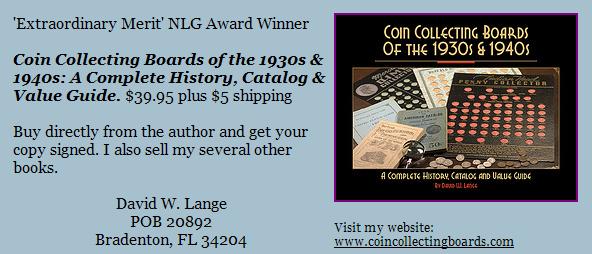
ALAN WEINBERG'S 2008 BALTIMORE ANA DIARY
I speculated two weeks ago that it seemed to me to be ironic that the Australian "Charlotte 1788" hand-engraved silver medal that auctioned by Noble Coins in Australia for precisely $750,000 AUS plus the buyer's fee to the Australian National Maritime Museum was precisely the Noble auction catalogue estimate and also the amount that Noble and consignor Dr Chapman had spoken of to the media for weeks preceding the auction. I wondered if that wasn't just the reserve.
I raised this subject in a conversation at the Baltimore ANA with an Aussie dealer who claimed to have attended the sale . He took umbrage and claimed that the winning bidder and the two immediate underbidders were all museums! I momentarily accepted that until it dawned on me that museums traditionally have very limited funds and it is highly unlikely that three museums would be bidding in the rarified atmosphere of $500,000+ AUS dollars. Hmmm.
The entire exhibit area was so educational, interesting and unusual in the material. Those of you who could not tear yourself away from the bourse to view the exhibits really missed out. And those of you who keep your treasures in the dark and don't exhibit them are really missing out. Down thru numismatic history, virtually all the advanced collectors exhibited their finest material.
I noticed a very substantial increase in the number of dealers offering medals, tokens, political buttons and other interesting ephemera on the ANA bourse. Evidently many dealers are getting tired of slabbed Morgans, generic gold coins and the like. And this unusual material was selling well, much of it within the financial reach of many collectors and most of it "raw" so collectors can fondle their acquisitions.
There was a near disaster on the bourse floor when a top heavy Whitman book case and video monitor fell over on top of a seven months pregnant female Whitman employee. Dr Robert Hesselgesser of early Bust dollar collecting prominence was fortuitously just across the aisle and rushed to her aid, stopping the bleeding and keeping the pressing crowd at bay. An ambulance was summoned and I heard that only a few stitches and some rest was necessary. It could have been a lot worse.
I wandered the bourse floor endlessly from setup to Saturday afternoon (when I departed for the APIC in Vegas) and I overheard and engaged in many conversations. Not one dealer said he was having a slow show and one oldtime dealer who never missed an ANA in many decades told me this was his 2nd best ANA ever and he specializes in exotic collectible coinage. It seems the economy and air fares and vehicle fuel haven't intimidated the bulk of serious collectors yet.
Dr. George Fuld, who has contributed so much to numismatic research, is currently working on a photographic census article on all known Getz 1792 and 1797 George Washington colonial patterns. I was able to "corral" seven different specimens at the ANA which were photographed in color in Baltimore by Tom Mulvaney, courtesy of Dennis Tucker at Whitman, for the forthcoming Fuld article.
Among the genuinely rare goodies available on the floor for actual purchase were the 2nd finest known choice Unc Norweb-Hain-Milas 1792 silver center cent pattern, a choice Unc 1792 ornamented edge Peter Getz George Washington "half dollar" ex Garrett-JHU-Roper-Milas, a silver 1797 George Washington Peter Getz Masonic silver "half dollar" ex-Garrett-JHU-Anton and an assortment of rare early American medals filling two cases at Tony Terranova's corner booth - at the end of the show these two cases were almost empty! Coins getting too expensive? Yes!
An entirely enjoyable, educational and inspiring five days in Baltimore. This is what the hobby is all about.
EARLY U.S. QUARTERS AND DOLLARS IN THE ERIC P. NEWMAN COLLECTION
These Wayte Raymond toned coins have scarcely been seen since purchased from the Colonel Green estate in the 1940s. Following these introductions were a mind blowing display of professional images by Rory and a continual murmur throughout the crowd. Browning plate mysteries were unveiled one by one. Image after image left my mind tortured to choose a favorite amongst the coins. I would "settle" for the 1807 B2 and the 1828 B3...please don't make me choose only one!
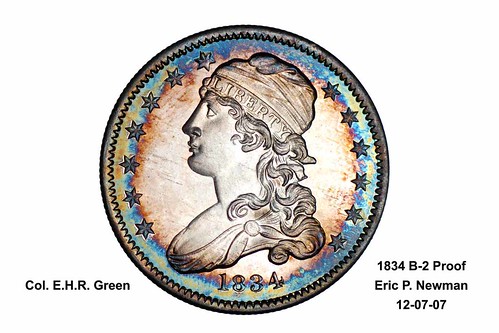
Dave took over the dollar part of the presentation and the eye candy kept flowing. In a moment of fitting irony an audience member queried what third party grade might be assigned to a coin? At that moment I was writing the words in my notes "STUNNING....OR BETTER". Ironically, as I write these words from gate 58 of the Denver airport a lone rabbit is wandering the tarmac in search of food; just as unlikely to succeed as a collector might searching the bourse for a coin of the quality seen in this display.
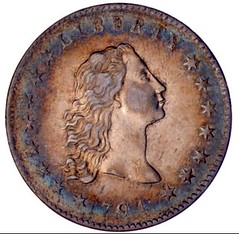
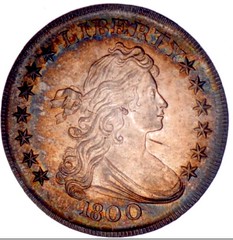
Following this highlight would prove difficult. Yet, in a quiet corner of the bourse a lone early quarter sat amongst a set of high grade coppers. The Eliasberg 1807 B1 exhibited blazing luster overlaid with a soft mellow original skin. Truly beautiful. Reluctantly, I returned the coin after a long visit.
To view four slides from the presentation, see: Eric P. Newman Coins (http://www.flickr.com/photos/coinbooks/sets/72157606656307912/show/)
DANIEL CARR DESIGNS WIZARD COIN SUPPLY 2008 ANA COMMEMORATIVE TOKEN
The commemorative tokens will be available to World's Fair attendees at Wizard's booth (booth 1229) during the show which runs from July 30th to August 3rd. The pieces will also be available on Wizard's website while supplies last. .With a limited edition of 500 pieces, this fabulous token is destined to become a popular collector item. says Wizard.s Lady Karin Herndon (Wizard eschews traditional titles in favor of thematic ones).
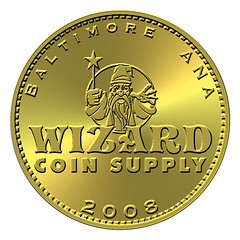

The tokens, which also double as a gift certificate, carry a face value of $25 (their issue price) and are redeemable forever at Wizard Coin Supply for $25 in coin supplies. The tokens are struck in brass and measure 38.75 mm in diameter (a little larger than a silver dollar). Mintage is limited to 500 pieces to assure these pieces remain rare. Wizard anticipates periodic future issues with different designs as circumstances warrant gradually building to a series of collectible tokens.
Wizard Coin Supply is a global provider of coin collection supplies and coin collection accessories, based in the Washington DC suburbs of northern Virginia. Wizard is dedicated to providing its customers with the largest possible selection of quality coin supplies at deeply discounted prices and to promoting the hobby and enjoyment of numismatics.
Designer Daniel Carr received a B.S. degree in Mechanical Engineering from the University of Colorado in 1982. He also studied computer graphics and art extensively. He wrote his own digital sculpting computer software which he uses in an innovative process to create coins, medals, and tokens. In addition to submitting the winning design for the New York and Rhode Island state quarters, the final Maine quarter designed used by the Mint was based on Carr's design. In addition, Carr submitted designs that reached the finalist stage for the Wisconsin, Florida, California and Colorado quarters and the reverse of the Sacagawea Dollar.
QUERY: LOST CAUSE MEMORIAL PLAQUES
One example is available on the Library of Congress web site. Who knows where the others are? According to Fred, examples of Lost Cause plaques were later made using replica examples of CSA notes. I'm more interested in those that bear actual notes. Google hasn't been much help, although that may be my fault, and I have not yet tried to research auction house sales. I invite those so inclined to contact me via reply to The E-Sylum.

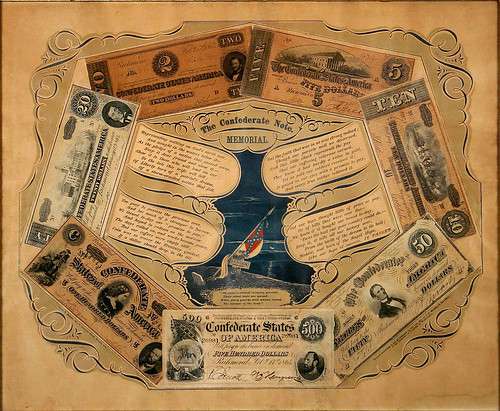
And naught in the waters below it,
As the pledge of a nation that's dead and gone,
Keep it, dear friend, and show it.
Show it to those who will lend an ear
To the tale that this trifle can tell
Of Liberty born of the patriot's dream,
Of a storm-cradled nation that fell.
Too poor to possess the precious ores,
And too much of a stranger to borrow,
We issued to-day our promise to pay,
And hoped to redeem on the morrow.
To read the full text of Jonas' poem, see: LINES ON A CONFEDERATE NOTE by Major Sidney Alroy Jonas http://www.civilwarpoetry.org/confederate/postwar/note.html
MORE ON BUTTONS AND COINS
Take for example the U.S. Centennial of 1876 and especially the Centennial Exposition in Philadelphia. The number of Expo souvenirs that were sold for that event is truly astonishing. The medals, of course, get the most attention from modern-day exonumists, but they were easily outnumbered by die-struck buttons, studs, pins, badges, cuff links, lockets, belt buckles, and even suspender snaps.
Mr. Johnson is right. It is striking (pun intended) how similar these mementos are in their manufacture: die-struck obverses with a dazzling array of reverses and/or shapes that betray their intended purpose. An Expo visitor with no numismatic bias might actually conclude that the medals could be defined simply as two-faced die-struck souvenirs with no discernible utilitarian purpose!
QUERY: ENGRAVED 1921-D MORGAN DOLLARS
Ginger Rapsus writes: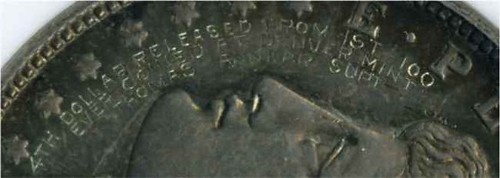 \
\For more information on specimen #4, see, see: Northern Nevada Dollar Error Gallery (http://www.brokencc.com/dollarerrors.php)
THIS IS TO CRY: ARTICLE DETAILS HISPANIC SOCIETY OF AMERICA'S PLANS
On August 6, Sotheby's began cataloguing for immanent auction a collection of 38,000 coins which Huntington lent to the American Numismatic Society. The HSA's board of trustees have assumed unfettered discretion to under-promote, under-protect and ultimately sell off Huntington's collection, in a process some analogize to Lorenzo's treatment of airlines during his heyday.
"This is to cry," a Spanish art lover sighed during a recent visit. It didn't have to be this way -- and the coin sale could still be stopped. Potential bidders should be aware of the history, particularly how the sale may run counter to not only the spirit but also the letter of Huntington's intent.
Despite Huntington's transfer of the coins to the American Numismatic Society being described as a "permanent" loan, the HSA has fought and litigated to regain the coins, but only for the purpose of selling them, not for display.
During an August 6 visit to the American Numismatic Society's new location at 75 Varrick Street, Inner City Press observed a team from Sotheby's and a spin-off company specializing in coin sales, Morton & Eden, preparing to catalogue the coins, which number 38,000. A sworn affidavit by Sotheby's David Redden spells out the auction house's demands during the cataloguing process: a separate, carpeted room to which they will have their own key, Internet access and, strangely, the right to bring in their own food. Once catalogued, the coins will be sold the highest bidders.
Lorenzo is best known for the bankruptcy of Eastern Airline; he has been described as, among other things, a "vulture investor." Now, museum sources say, he is applying to same slash and burn philosophy to the Hispanic Society of America, moving to sell off anything that is not nailed down. "It's a social club for a handful of businessmen," one well-placed source complained, describing these "gentlemen's" jockeying to meet Spanish royalty and other European dignitaries and titans of commerce.
 A visit to the museum by this reporter on a
recent Sunday found only a handful of tourists and two security guards.
The Society's library was closed to the public, and 16th century wood
carvings sat under a leaking ceiling with peeling paint. Upstairs, rare
ceramics sat on the floor next to electric fans of the type sold in
discount stores, protected only by a two-foot high strip of plastic or
Lexan. Even though no direct comment was offered for this initial story,
it emerged that the HSA's trustees have also considered leaving 155th
Street, but concluded that space lower in Manhattan was too
expensive.
A visit to the museum by this reporter on a
recent Sunday found only a handful of tourists and two security guards.
The Society's library was closed to the public, and 16th century wood
carvings sat under a leaking ceiling with peeling paint. Upstairs, rare
ceramics sat on the floor next to electric fans of the type sold in
discount stores, protected only by a two-foot high strip of plastic or
Lexan. Even though no direct comment was offered for this initial story,
it emerged that the HSA's trustees have also considered leaving 155th
Street, but concluded that space lower in Manhattan was too
expensive.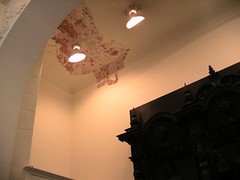 Other trustees beyond Frank Lorenzo include
William R. Harman, Miner H. Warner and George B. Moore, who signed the
Trojan horse revised loan agreement, and who works at Merrill
Lynch.
Other trustees beyond Frank Lorenzo include
William R. Harman, Miner H. Warner and George B. Moore, who signed the
Trojan horse revised loan agreement, and who works at Merrill
Lynch.None of these were present on Wednesday when Sotheby's began final cataloguing of the coins at the American Numismatic Society. The Sotheby's group were behind a locked and secured door, presumably with the lunch they had brought in. Archer Milton Huntington, one imagined, was rolling in his grave. Will his voice and intent be heard, before at Frank Lorenzo's direction, Huntington's hard-won collection disappears into the hands of the highest bidder?
To read the complete article, see: Spanish Coins Face Stealth Sale by Secret Museum, Frank Lorenzo Is Said to Change Hispanic Society of America (http://www.innercitypress.com/nyc1hsa080608.html)
ASSOCIATED ITEMS ADD INTEREST AND COLOR TO ARTICLES AND BOOKS
An associated item -- a nonnumismatic item closely related to a numismatic item -- can take many forms. These "go-with" items can be most any relevant artifact, but photographs top the list. Or drawings, paintings, any other illustrative material. Bill Swoger also included the leaflets that come with the medals, stamps, tickets, badges, first day covers, postal cards, medal envelopes, order forms, expo certificates, and in one case, a painting and paper money showing the same design as on the medal. Often they illustrate an event connected to the coin, medal or token.
These all add interest and colorful background information when illustrated with any numismatic item. Collectors should add these when forming their collections. Writers should search for such associated items in the preparation of any book or article.
The Lincoln Tunnel Medal article was by Harry Waterson. He had found and illustrated an invitation to a celebration dinner honoring the opening of the Lincoln Tunnel. It had a tab to turn in for a free medal during the festivities. His other illustration was a matchbook with a drawing of the medal. Both relevant items to the medal. The article is slated for publication soon in TAMS Journal. Watch for it and see if you don't agree with me associated items add interest.
WAYNE'S NUMISMATIC DIARY: AUGUST 2, 2008
Pulling into the town I felt like a fly on the wall. Walking about the city were numismatists in every direction, but it would have been awkward if not dangerous to start conversations. As we waited for the first traffic light I watched numismatic literature dealer Charlie Davis and his tablemate Fred Ouellette cross the street. Next I spotted Redbook editor Ken Bressett and told Dee "we can follow him to the banquet."
Ken was heading in the right direction - I pulled my car in the garage of the Marriott Renaissance Harborplace hotel. It turned out to be easy and cheap parking - a $10 event rate. I was afraid I'd only find stratospheric parking rates nearby, and Dee had already forbidden me to park farther away - hiking in heels is not fun.
We made our way upstairs and quickly found the reception area outside the banquet room. We got in line at the cash bar. I bought a glass of red wine. It was $10 a glass, making me wonder if Baltimore was having an "everything's $10" night.
It's been a couple years since we moved from Pittsburgh, and we sought out our fellow Pennsylvanians. Among those we chatted with were Sam Deep, his son David, and grandson Josh Wadsworth. From the Lancaster area we spoke with PAN members John Eshbach and Dick Duncan. Other folks we had nice chats with included Ken Bressett, George Cuhaj, former ANA Librarian Nancy Green and John and Nancy Wilson.
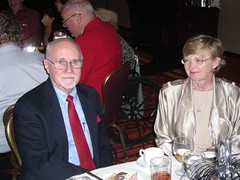 John was pointing his camera in every
direction, getting shots of people left and right. He'd been doing this
all convention long. Here's a photo of Nancy Green with Farran Zerbe Award
Winner Gene Hessler).
John was pointing his camera in every
direction, getting shots of people left and right. He'd been doing this
all convention long. Here's a photo of Nancy Green with Farran Zerbe Award
Winner Gene Hessler).Brad Karoleff walked by and I buttonholed him for a report on the NBS meeting and fundraising auction. For a number of years Brad has called the auction for us. I'd already heard about Brad's antics, where he sweettalked, cajoled, browbeat, pressured, toyed with, teased, embarrassed, strongarmed or tricked the audience into a bidding frenzy. This year he outdid himself and the auction raised thousands of dollars for NBS. It sounded like a hoot - I'm sorry I missed it, but my wallet is better for it.
When the doors opened we made our way up front to table number four. Our tablemates were David Sklow, Susan McMillan, Dan Gosling and his wife, Wendell Wolka and his wife, and a couple from Lancaster. I hadn't met them before, but they were Red Rose Coin Club members and knew our PAN friends well. At nearby tables were David Harper, Beth Deisher, Chet Krause and ANA Executive Director Larry Shepherd.
Following the banquet a number of folks stopped by to congratulate me, including Sam Deep, the ANA's Kim Kiick and former ANA Governor Walt Ostromecki. Walt recalled the time many years ago when I went out to a Long Beach show to run a workshop for California coin club officers on how to build club membership and meeting attendance. I'd almost forgotten about it, but Walt said the workshop and been valuable. I was actually just filling in for Sam Deep when another commitment came up, but I based my talk on experiences with Western Pennsylvania coin clubs. I'm glad that some of my advice proved helpful.
On the way out I stopped to say hello to the ANA's travel agent Paul Whitnah and former Executive Director Ed Rochette. In the elevator on our way down to the parking garage a woman introduced herself to me - it was E-Sylum subscriber Laura Robins, who introduced me to her son Will, who'd won an award of his own at the banquet. She said I looked different than she'd expected. I guess I should update my Wayne's Words photo, but I'm lazy. Anyway, this issue has some fresh ones.
We couldn't stay and talk, since we had to get back home to our kids. It turns out four-year-old Hannah was crying for her Mom and refusing to go to bed. At night she's a 35-pound Mommy-seeking missile. By day she's a sweetheart and just might have Dad's collecting genes in her. She has a rock collection and a leaf collection, all her own idea. As I was drafting this diary I discovered four leaves in my pocket - she found them in our yard today and asked me to put them in her collection. "Zuzu's petals", I thought, as I put them in the zip-lock bag with the rest of her collection in a drawer in her play room.
The convention is history now, but it was another great one. Let's hear from some of our readers - what did you enjoy most about the convention? What research projects or new books did you hear about? Let us know!
For a short slideshow, see: A few of John Wilson's 2008 Baltimore ANA photos (http://www.flickr.com/photos/coinbooks/sets/72157606660786879/show/)
MONEY IN MOTION: NUMISMATIC EXHIBIT AT PHILADELPHIA FEDERAL RESERVE BANK
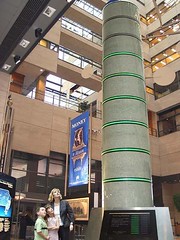 With all the troubling economic news swirling
around for the last year or so, I grew curious about the Fed and its head
and, although I had passed by the Federal Reserve Bank in Philadelphia
many times, didn.t know much about its function or importance. When I saw
that the Fed was hosting a permanent exhibit, Money in Motion, a History
of Banking, Money and the Federal Reserve, it seemed like a good
opportunity to educate myself.
With all the troubling economic news swirling
around for the last year or so, I grew curious about the Fed and its head
and, although I had passed by the Federal Reserve Bank in Philadelphia
many times, didn.t know much about its function or importance. When I saw
that the Fed was hosting a permanent exhibit, Money in Motion, a History
of Banking, Money and the Federal Reserve, it seemed like a good
opportunity to educate myself.Money in Motion, designed by DMCD Inc. of New York, incorporates innovative and elegant technology into the 16 elements of the exhibit installed to one side of the atrium of the Fed building. The free financial exhibit is suggested primarily for high school age students and adults and takes about 45 minutes to complete.
Guides are on hand to answer questions, and bid you farewell with a postcard and a small bag of shredded money, which looks a little like catnip.
Visitors can trace the changes in our national currency from the early 1600s to today. Paper money and coins from the original 13 colonies are on view, giving the viewer an idea of what things were like before our system was unified.
You.re greeted, literally, by a .Benjamin. . a $100 bill adorned with Benjamin Franklin.s face. It comes to life when Philadelphia actor and Franklin impersonator Ralph Archbold welcomes you to the exhibit. The real Benjamin Franklin had a key role in the birth of America.s paper money economy. As a young man, he helped design and print paper money authorized by the New Jersey legislature. He later invented the art of nature printing from leaf casts, via a copper plate press, for transferring a sage leaf image onto the back of paper money bills, a technique intended to thwart counterfeiters.
Other highlights of the exhibit include:
A rare $100,000 gold certificate . the highest value bank note ever printed by the Bureau of Engraving and Printing . as well as a tower of dollar bills totaling $100 million and a currency cart representing $1,650,000 in $5 bills; .Supervision Mission,. which lets you take .The Bankers Challenge. and test your knowledge as you advance from trainee, to loan manager, to investment manager; .Crisis Management. walks the visitor through the Fed.s crisis management techniques. (For example, we see how the Fed kept the economy going during the aftermath of Sept. 11, 2001.)
My favorite segment was .Payments 2200,. where a teller of the future interacts with the viewer, explaining the role of cash, checks, credit, debit and automatic transactions in the year 2200. The young woman, who looks a little like a futuristic Mrs. Peel from the old TV show The Avengers, first asks you to stand still so she can scan for a retina implant or identifying microchip. When this fails, she says, .Oh, you must be from the past.. When you indicate that you want to pay for your purchase . a new hovercraft . with a check, she says, .We don.t see those around too much anymore,. and suggests checks are one of those .antique. methods of payment, along with barter and cash. Indeed, I just read that checks are already going the way of the milkman and drive-in movie theater.
Money in Motion might not be a roller coaster of thrills, but anyone curious . and serious . about money, banking and the economy will find the exhibit compelling, cogent and elegantly executed.
Plus, in times when money is tight, being in a building where, on any given day, there is between $5 and $8 billion in paper money . stashed in vaults the size of a football field . fires the imagination.
Money in Motion, a History of Banking, Money and the Federal Reserve is on view at the Federal Reserve Bank of Philadelphia, 100 N. 6th St., Philadelphia. Extended summer hours: Mon.-Fri. 9:30 a.m.-4:30 p.m., Sat. 10 a.m.-4 p.m., Sun. noon-4 p.m., through Aug. 31. Open Sept.-May, Mon.-Fri., business hours. (866) 574-3727; www.philadelphiafed.org
To read the complete article, see: We.re in the Money: Learn all about our nation.s monetary system at the Federal Reserve Bank. (http://www.packetonline.com/articles/2008/07/30/
time_off/entertainment_news/doc4890b36651073873209996.txt)
WISCONSIN NEWSPAPER NOTES LOCAL BUSINESS MENTIONED IN BURDETTE BOOK
The business for many years was owned by the Brandt-Quirk families in Watertown and through the families and the employees much has been given to the Watertown community in many ways.
The book is titled .Renaissance of American Coinage, 1916-1921. and it was written by Roger W. Burdette.
The book traces the complete redesign of America's coins by the United States Mint.
It's a detailed accounting of the origin, creation and ultimately the production of these coins starting back in 1916. In this era all of the coins, from the Peace Dollar down to the nickel were redesigned.
So, where does Brandt Automatic Cashier Company come in? Well, back in that era the company was manufacturing thousands of its trademark coin counting, sorting and wrapping equipment and it was known throughout the country for its quality work.
These new coin designs simply had to work well in the Brandt machines because they were used throughout the country. Any tampering with coins that would render the Brandt equipment ineffective could be a disastrous situation, from incorrect counting to jammed and broken machines.
Brandt was one of only three companies in the country that was given some of the newly designed coins for test purposes. The coins had not gone into full production but rather just a few were minted to determine if they would work well in equipment like Brandt manufactured and in such equipment as pay telephones.
Burdette wrote to us and said he noticed an article by Steve Sharp of our news staff which chronicled the decision that the Edward J. Brandt House in Watertown was being placed on the National Register of Historic Places.
That led him to decide to write about his book. He said, .Brandt was a leading Watertown businessman and founder of the Brandt Cashier Company, a major industry in Watertown in the early 20th century. What you might not be aware of is that Mr. Brandt's company played an important national role in evaluating the new coinage design of the United States in 1916, and determining their suitability for coin-operated devices. While researching historical documents for my book I contacted Brandt, Inc., and obtained a copy of the biography, .Edward J. Brandt, Inventor,' by former company vice president Charles J. Wallman. Neither Mr. Wallman's book mentions, nor company officials knew, of the company's connection with the U.S. Mint. I was told that most company records before 1920 had been destroyed..
To read the complete article, see: BRANDT MENTIONED IN BOOK (http://www.wdtimes.com/articles/2008/08/02/in_times_square/times01.txt)
FOREIGN COINS JAMMING COUNTING MACHINES DONATED TO UNICEF
When Israel was a president of Pitkin County Bank, more than 20 years ago, he became frustrated by all of the foreign coins that were coming back from people.s vacations and jamming up the bank.s machines.
.We had a coin machine that foreign coins were jamming and at the same time, various machines in town like parking meters were being jammed by foreign coins,. said Israel. .With our coin machines we would have trouble counting people.s coins. We pulled them out and put them aside..
.I started using those coins to create funding for a scholarship for children.s education that still goes on at the high school today,. Israel said.
It wasn.t until a personal trip to Europe that Israel first heard about Change for Good program sponsored by the United Nations Children's Fund, better known as UNICEF.
After calling to find out more about the program Israel began collecting and sending all of the foreign coins from the bank to the Change for Good fund.
To read the complete article, see: Man turns unwanted coins into helpful cash (http://www.aspentimes.com/article/20080803/NEWS/
911661776/1077&ParentProfile=1058)
CANADA'S KING'S POLICE AND FIRE SERVICE MEDAL
After an explosion on board a Fairmile warship at the Hunter Boat Works, Orillia fire Capt. Elgin R. Jones entered the burning engine room to seal a leaking tank containing more than 2,000 gallons of high-octane fuel.
If the fuel tank had exploded, the legion in a converted railway station beside the boat works might have been levelled, said McRae.
"Not only was the CPR station spared, but with fuel storage along the waterfront, and Canada Wood's stockpiles of lumber along the rail line, the threat to our downtown would have been obvious to the chief."
For his valour, Elgin was presented with a King's Police and Fire Service Medal, one of only 52 presented in Canada's history.
Fire Lt. Daniel McLeish, who hosed down flames while Elgin worked on the fuel tank, also received a King's medal.
When Elgin's medal recently turned up for sale on eBay, the local fire department decide to raise the $6,000 purchase price to bring the medal back to Orillia where Elgin left no descendants.
To read the complete article, see: Legion hopes to raise cash for medal (http://www.orilliapacket.com/ArticleDisplay.aspx?e=1137730)
SALE OF VICTORIA CROSS REPLICAS CRITICIZED
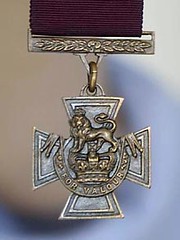 The British National Party has been accused of
insulting troops by selling replicas of medals including the Victoria
Cross for #12.
The British National Party has been accused of
insulting troops by selling replicas of medals including the Victoria
Cross for #12.Although not illegal, the Ministry of Defence has condemned the sales of the fake honours as "an insult to both he Queen and our brave personnel".
MPs similarly criticised the far-right party for exploiting the sacrifices of servicemen for financial gain.
Also for sale on the party's official website are replicas of three World War II campaign medals and a World War I medal.
The Victoria Cross is the highest military decoration for valour in the face of the enemy to members of the armed forces.
Under strict military rules, only armed forces heroes who have won the cherished medals in combat - or their widows - are allowed to wear them.
Tory MP and ex-Army officer Patrick Mercer called on Defence Secretary Des Browne to make the BNP sales illegal.
He said: "This is utterly shameful. Medals for gallantry and campaigns are absolutely nothing to do with any political party. The Defence Secretary should look at this to see whether legislation should be introduced to forbid it."
To read the complete article, see: BNP criticised for selling replicas of Victoria Cross (http://www.telegraph.co.uk/news/2514940/
BNP-criticised-for-selling-replicas-of-Victoria-Cross.html)
DENVER MINT TO CLOSE DURING 2008 DEMOCRATIC NATIONAL CONVENTION
Mint spokesman Greg Hernandez in Washington said the plant will get its annual physical inventory and workers will perform maintenance on machines.
The convention is August 25th through 28th. Last year's maintenance was performed July 23rd through 27th.
The Denver Mint is on Colfax Avenue, the designated route for protest marches, and is about two blocks from Civic Center park, the designated staging area for marches.
To read the complete article, see: Penny producer out of production during DNC: Denver Mint closing down for week (http://cw2.trb.com/news/kwgn-denver-mint-closing-dnc,0,4174929.story)
AUTHOR RUSTY GOE REWARDS YOUNG NUMISMATIST
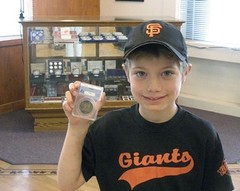 A Reno boy who correctly answered six questions
about the year 1808 had his name drawn Tuesday as the winner of a
200-year-old half-dollar coin.
A Reno boy who correctly answered six questions
about the year 1808 had his name drawn Tuesday as the winner of a
200-year-old half-dollar coin.Garrett Allen, 8, was picked randomly out of hundreds of entries at Southgate Coins, 5032 S. Virginia St.
Allen is a third-grader at Silver Lake Elementary School in north Reno. He said he got the answers to the coin shop's questions by using the internet, a book on presidents and a coin book.
He's interested in coin collecting and said, now that he has the 200-year-old half-dollar, he'll "probably save it and keep it safe."
Children age 12 and younger were eligible to enter.
To read the complete article, see: Boy wins rare coin in contest (http://www.rgj.com/apps/pbcs.dll/article?AID=/20080806/NEIGHBORHOODS/808060403/1247)
BOOK TOWNS: SCENIC VILLAGES DEVOTED TO USED BOOKS
To read the complete article, see: International Association of Book Towns, for scenic villages devoted to used books (http://www.boingboing.net/2008/08/09/international-associ.html)
To view the I.O.B. web site, see: I.O.B. - International Organisation of Book Towns (http://www.booktown.net/)
HOW DID FLIPPING A COIN BECOME A DECISION-MAKER?
To read the complete article, see: How did flipping a coin become a decision-maker? (http://honeyandfunny.blog.co.in/2008/08/04/
how-did-flipping-a-coin-become-a-decision-maker/)
FEATURED WEB PAGE: YAP STONE MONEY
This week's featured web page is a question-and-answer style article from the BBC on Yap Stone money. We may have already highlighted this page (it looks familiar), but what the heck - it's a good one.From the web site:
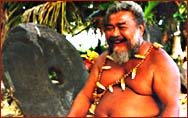
http://news.bbc.co.uk/hi/english/static/road_to_riches
/prog2/tharngan.stm

